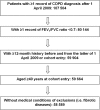Risk factors for acute exacerbations of COPD in a primary care population: a retrospective observational cohort study
- PMID: 25524545
- PMCID: PMC4275672
- DOI: 10.1136/bmjopen-2014-006171
Risk factors for acute exacerbations of COPD in a primary care population: a retrospective observational cohort study
Abstract
Objectives: To evaluate risk factors associated with exacerbation frequency in primary care. Information on exacerbations of chronic obstructive pulmonary disease (COPD) has mainly been generated by secondary care-based clinical cohorts.
Design: Retrospective observational cohort study.
Setting: Electronic medical records database (England and Wales).
Participants: 58,589 patients with COPD aged ≥40 years with COPD diagnosis recorded between 1 April 2009 and 30 September 2012, and with at least 365 days of follow-up before and after the COPD diagnosis, were identified in the Clinical Practice Research Datalink. Mean age: 69 years; 47% female; mean forced expiratory volume in 1s 60% predicted.
Outcome measures: Data on moderate or severe exacerbation episodes defined by diagnosis and/or medication codes 12 months following cohort entry were retrieved, together with demographic and clinical characteristics. Associations between patient characteristics and odds of having none versus one, none versus frequent (≥2) and one versus frequent exacerbations over 12 months follow-up were evaluated using multivariate logistic regression models.
Results: During follow-up, 23% of patients had evidence of frequent moderate-to-severe COPD exacerbations (24% one; 53% none). Independent predictors of increased odds of having exacerbations during the follow-up, either frequent episodes or one episode, included prior exacerbations, increasing dyspnoea score, increasing grade of airflow limitation, females and prior or current history of several comorbidities (eg, asthma, depression, anxiety, heart failure and cancer).
Conclusions: Primary care-managed patients with COPD at the highest risk of exacerbations can be identified by exploring medical history for the presence of prior exacerbations, greater COPD disease severity and co-occurrence of other medical conditions.
Keywords: PRIMARY CARE; chronic obstructive pulmonary disease; database; electronic medical records; exacerbations.
Published by the BMJ Publishing Group Limited. For permission to use (where not already granted under a licence) please go to http://group.bmj.com/group/rights-licensing/permissions.
Figures



References
Publication types
MeSH terms
Grants and funding
LinkOut - more resources
Full Text Sources
Other Literature Sources
Medical
Miscellaneous
